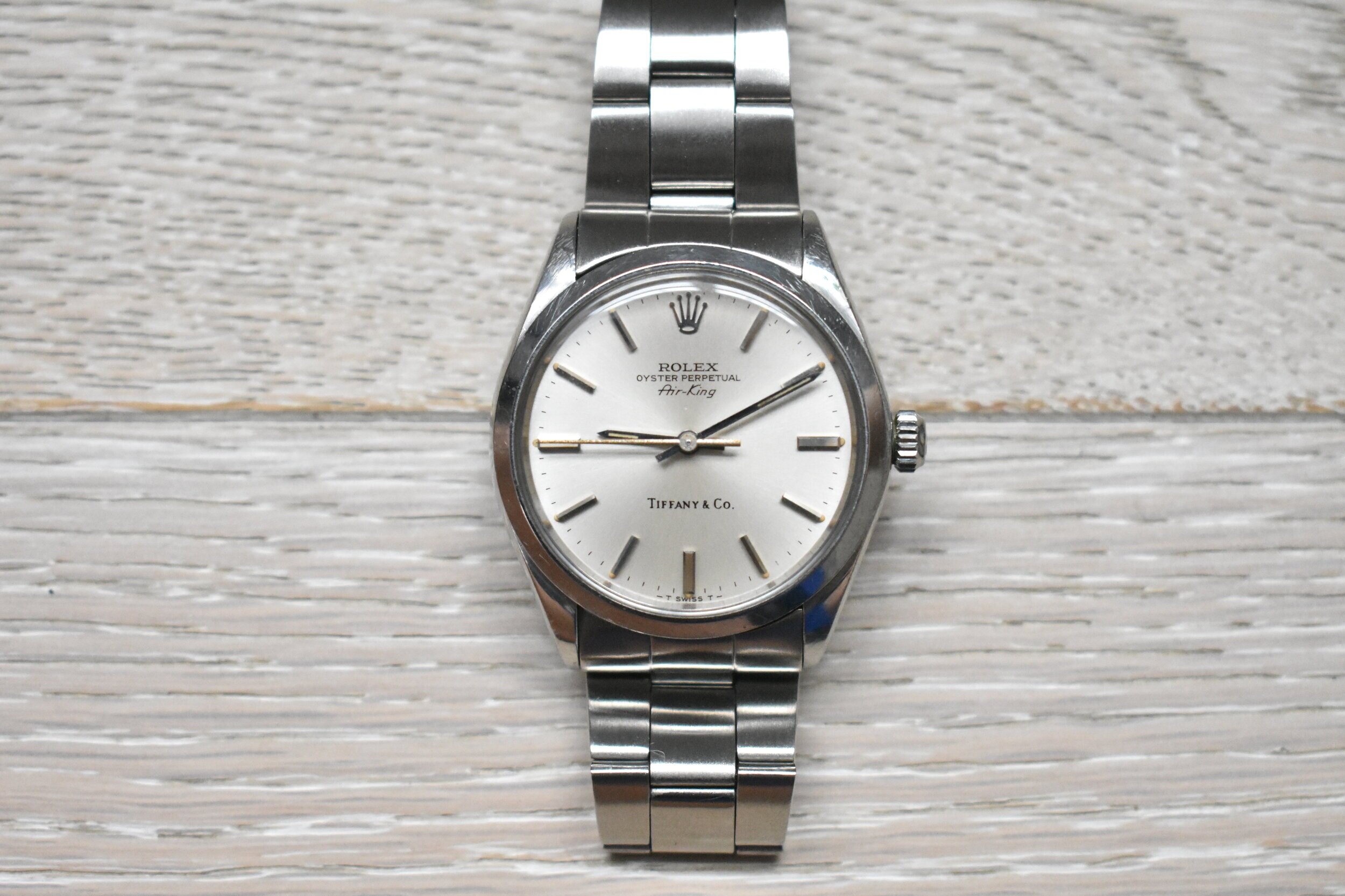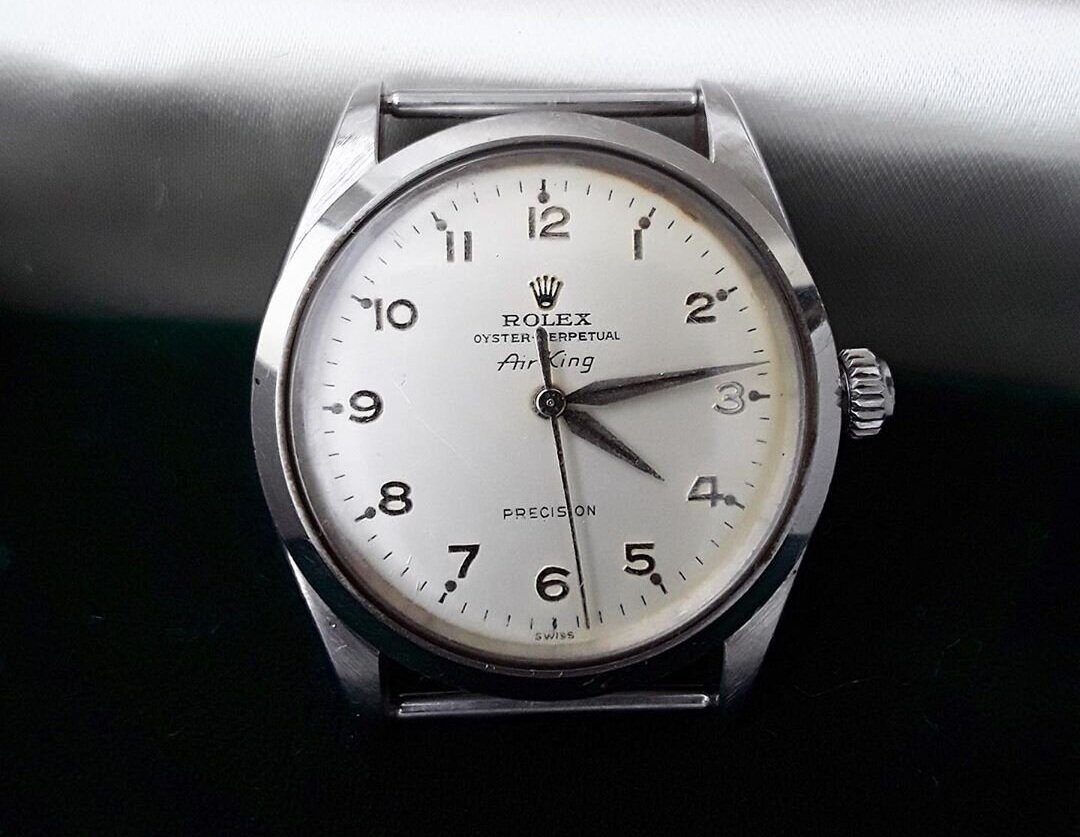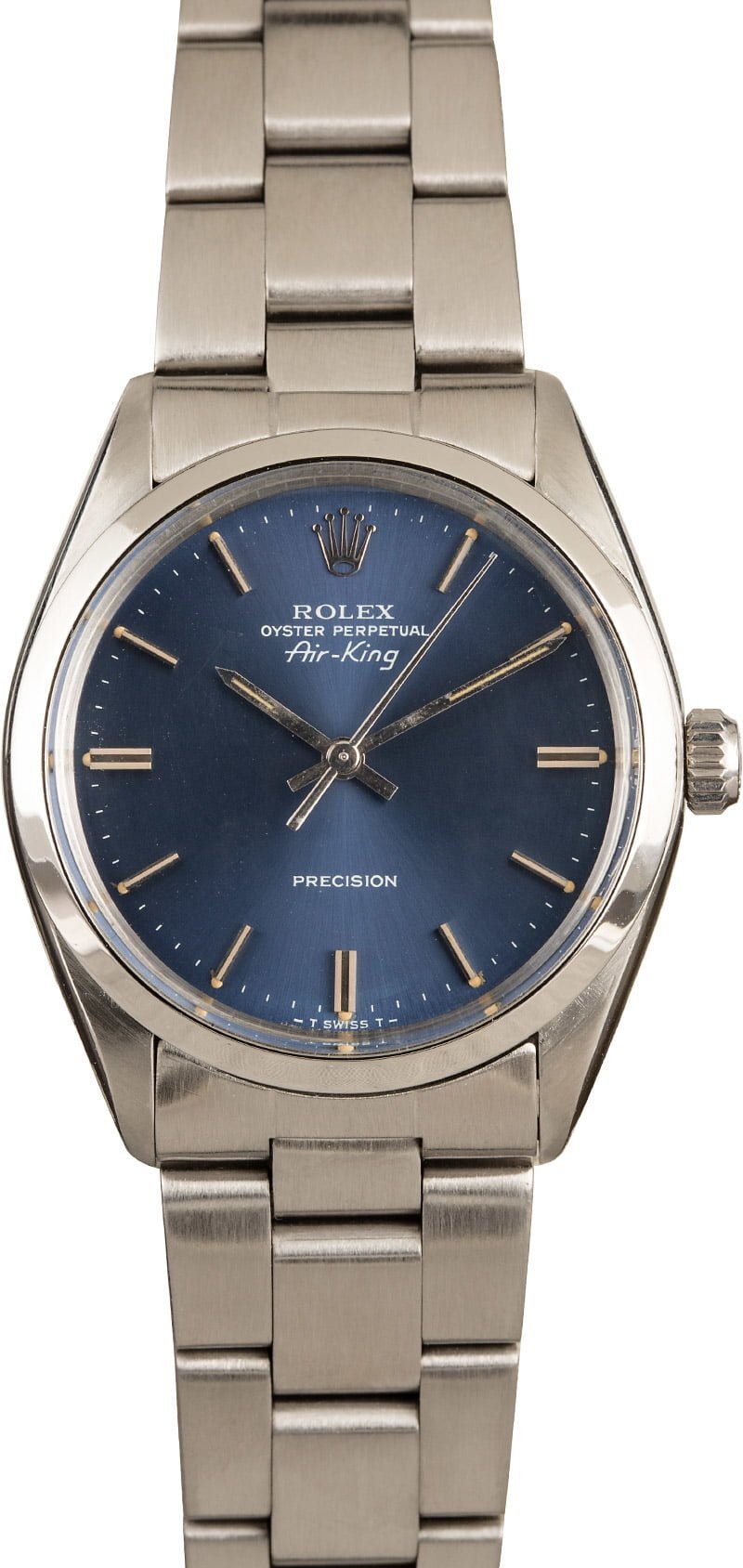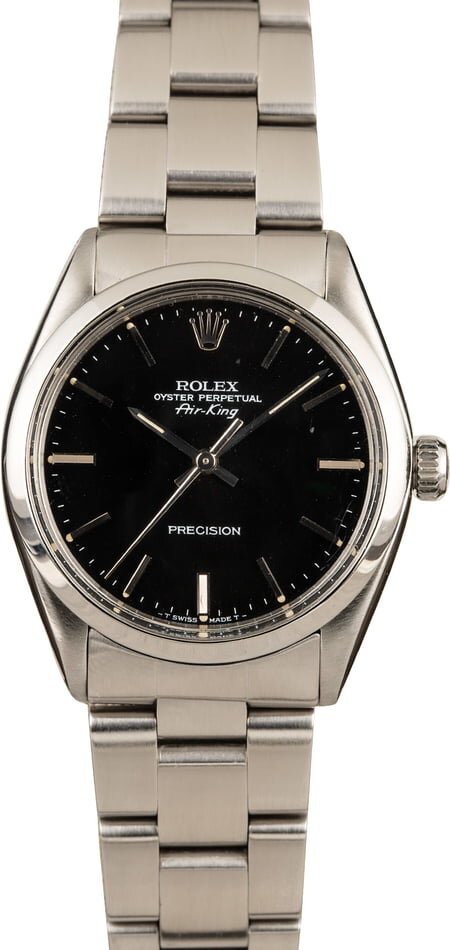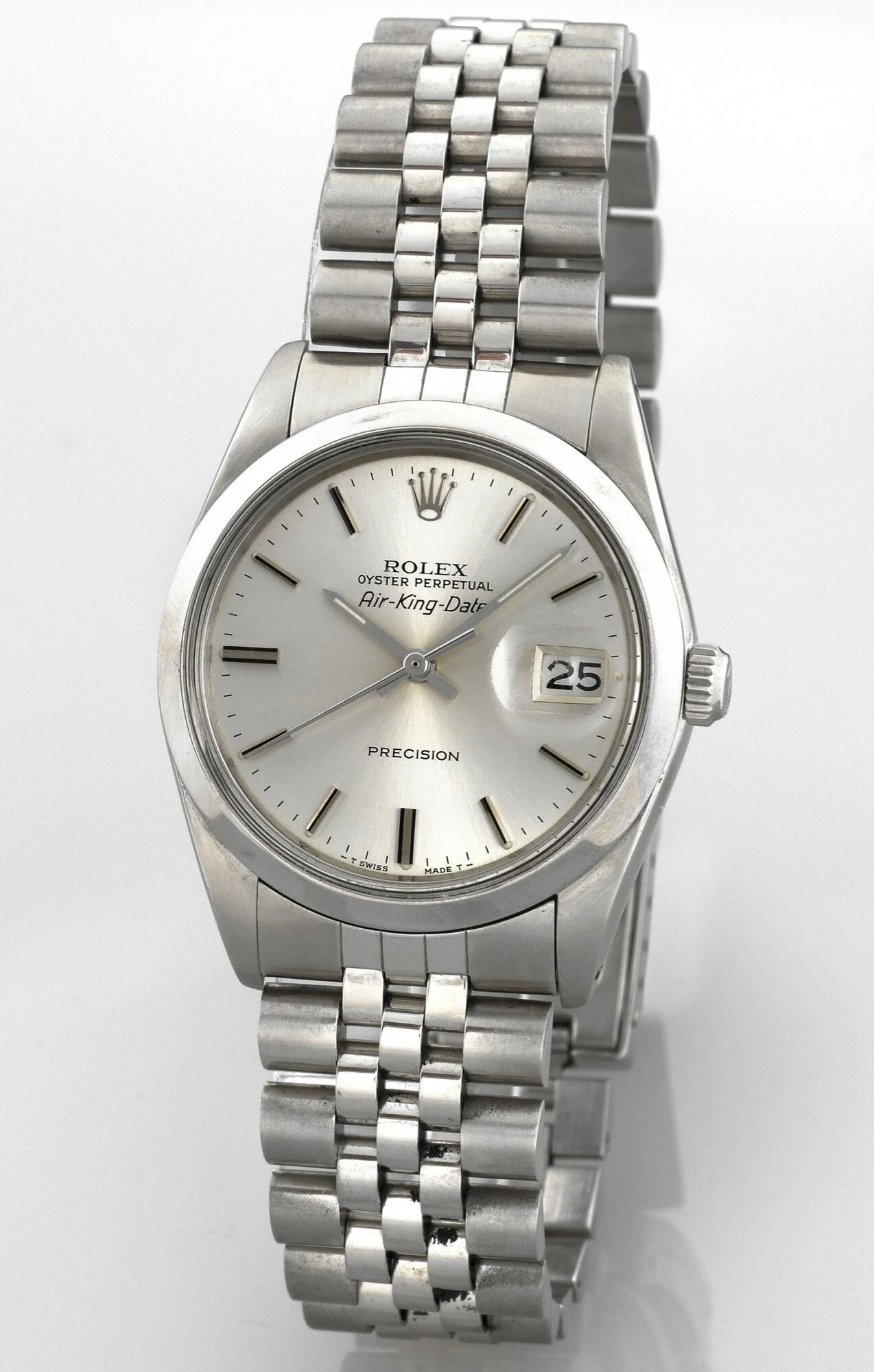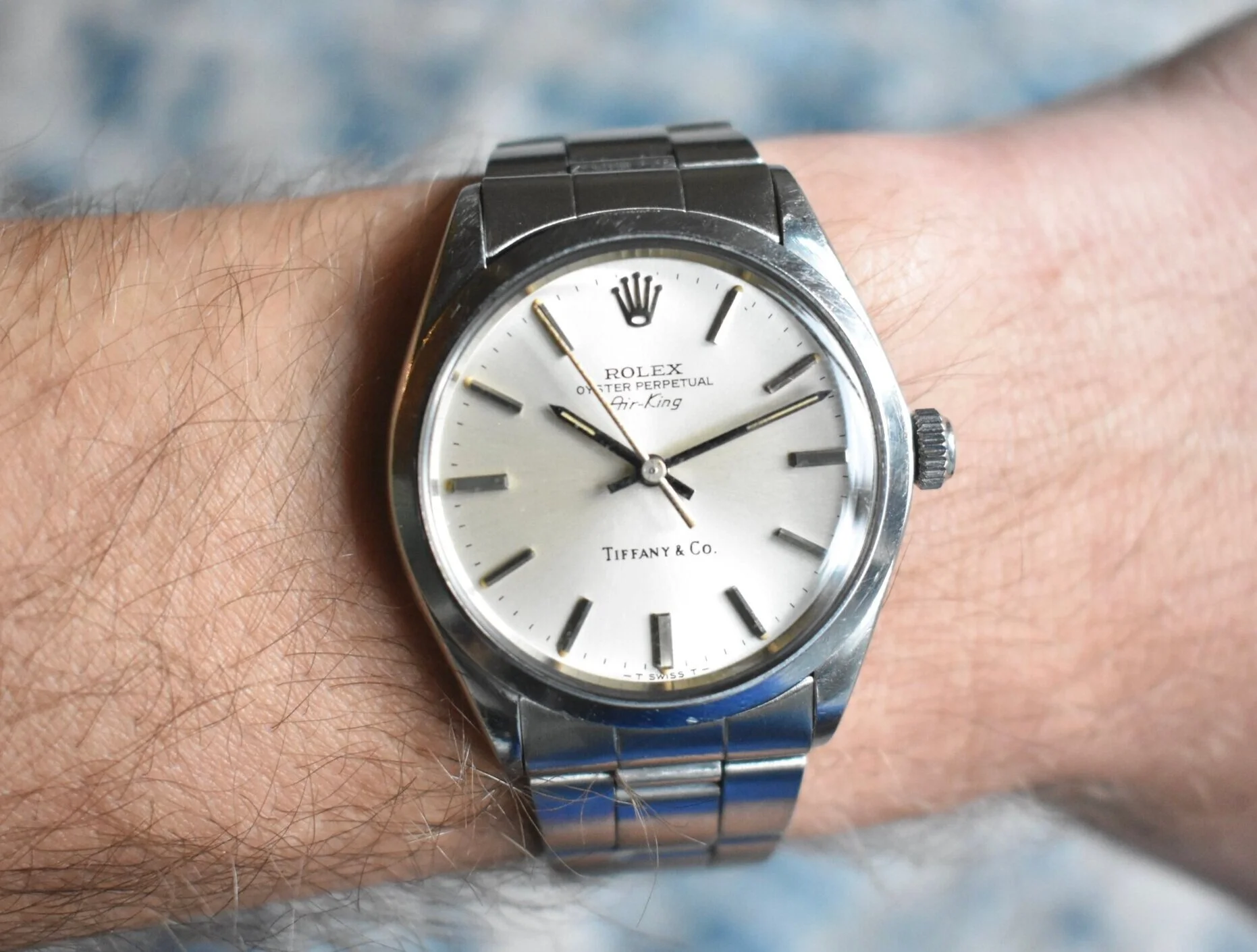I’ve given a brief history of the Rolex Air-King before, but today we’re going in-depth on the longest-running model in the Air-King’s history: the Air-King Reference 5500. Manufactured for over 30 years, the reference 5500 is one of the longest-running models in the history of Rolex. Introduced in 1957 and remaining in production until it was replaced by the Reference 14000 in 1989, it’s truly an iconic Rolex model.
The reference 5500 is a continuation of the Air-King name that Rolex first introduced with the Reference 4925 in the 1940s alongside names like Air-Giant, Air-Lion and Air-Tiger that flamed out. Rolex had originally introduced the Air-King as a variation of the Oyster Perpetual, intended to honor RAF pilots who served during World War II.
While this particular Air-King may not drive the passion of collectors like some more popular Rolex models, there is still plenty here for a budding enthusiast to sink his or her teeth into. And, since the Air-King continues to fly under the radar, even the most rare of Air-Kings can typically be had at an affordable price.
So let’s dig in, first by looking at the “standard” Air-King reference 5500 and then exploring the model’s development and some of its more interesting variations.
Reference 5500: The Specs
The standard, catalog Air-King reference 5500 measures 34mm in diameter; petite, even by standards of its era. The entire Air-King lineup (until the modern version, that is) is notable for its simple, clean, time-only design. The standard reference 5500 dial is an elegant silver with a gentle sunburst effect that emanates from the center of the dial. The sharp, applied indices are topped with small lume plots towards the outer edge of the dial, giving the dial a more elegant feel than the large, painted lume plots common on other Rolex sports models of the era. The hands look like typical baton hands, featuring lume about halfway up, but do come to a point at the end like a pencil.
There is often confusion about whether there was an Air-King reference 1002. There was not. The reference 1002 was an Oyster Perpetual produced from the 1950s through the 1980s, with the same case size as the reference 5500, but featuring a COSC-certified caliber 1560 movement. Because they had the same case size, Rolex often used case backs stamped 1002 on Air-King 5500 models. In earlier years of production, you might find an Air-King with the inside case back stamped “5500”, but by the 1970s, they’re typically stamped “1002.” This is not a service case back and can be completely correct and original.
Finally, the reference 5500 uses an Oyster case and screw down crown; Rolex rated its depth to 50m. This was all topped with a domed, acrylic crystal. In short, the Air-King possesses all the traits you’d expect from Rolex, without any superfluity: screw-down Oyster case, in-house automatic movement, and an accompanying Oyster bracelet.
Caliber for a King
Due to U.S. import laws designed to protect fledgling domestic watch manufacturers at the time, the movement inside the Air-King reference 5500 varied. The caliber 1520 had either 17 or 26 jewels, while the caliber 1530 had 17, 25, or 26 jewels. The U.S. and Canadian markets suffered through the “downgraded” movement with less jewels. For examples with the caliber 1520 inside, Rolex used the word “Precision”, or no text at all, at the 6 o’clock dial position. Those with the caliber 1530 used the words “Super Precision.” Neither were COSC-certified movements. These aren’t exactly top-of-the-line movements: you can often hear them rattling around on your wrist like a beat up Seiko 5, but the movements are also robust and known to be easy to service. This, along with the relative affordability of a vintage reference 5500, makes it the perfect daily wearer.
The caliber 1520 and 1530 are no slouches though: The Submariner Reference 5512 and 5513 were also both introduced with a caliber 1530 movement, with the Ref. 5513 continuing to use the caliber 1520 in later use, while the Ref. 5512 received a COSC-certified movement. The 1500 series of calibers from Rolex were the first movements created entirely in-house, ushering in a new era of manufacturing capabilities for the brand.
Oyster Bracelet
The Air-King’s lug width measures 19mm (the same as the Daytona of the era). With production of the reference 5500 spanning decades, a few different Oyster bracelets may be found on an Air-King.
Early production year examples will feature bracelet reference 7205, a rivet-style bracelet. Introduced in 1954, Rolex used this reference bracelet for a number of models, as the rivet style became a hallmark of Rolex until 1967, when it introduced bracelets with folded links. For the Air-King, this meant the introduction of bracelet reference 7835. The 7835 bracelet comes with either 257 or 357 end links to fit the 19mm lugs.
Finally, around 1975, Rolex introduced soild-link bracelets, with the reference 78350 bracelet and 557 end links coming to the Air-King.
Going Gold
I have not found definitive statements on this, but it seems the material of the hour indices varied over the reference 5500’s production run. While earlier models have markers made of the typical stainless steel, later runs — starting around the mid 1970s — seem to feature white gold markers that often have (or have developed) a yellow tint. I have also seen later versions that feature prominently yellow gold indices and hands, giving the watch an even more luxurious, “gilt” aesthetic.
Early Air-King Variations
While the reference 5500 eventually found its aesthetic stride in the mid-1960s — the baton pencil hands, stick indices and minimal text on the dial described above — the early years were highlighted by variation. For example, the reference 5500 can be found with alpha-style hands throughout the early 1960s. Rolex also used blue steel for the sweeping seconds hand on some examples.
A 1960 Air-King with alpha hands and blue steel second hand | Hodinkee Shop
Another fun early variation of the Air-King is the “Underline”, which features just a line at 6 o’clock. It’s generally believed that Rolex used the underline on various models for just a few years in the 1960s to signify its change from radioactive radium to tritium luminous material. Such dials typically emit significantly lower amounts of radiation as compared to their no-underline counterparts.
Perhaps most desirable among collectors are early variations with Arabic numerals. For example, early “dagger dials” have a 3-6-9 configuration with applied triangular daggers for the markers in-between. This variation can be found in both gold and stainless steel, with the applied ‘Rolex’ logo at 12 o’clock sitting above the printed “Air-King.”
A 1964 Rolex Air-King with ‘Dagger Dial’ | Black Bough
Another early example features Arabic numerals at every hour. It seems to be a rather rare variant; I’ve read conjecture that this was actually a British-only model, though I have little proof to verify this claim except tales from other collectors (perhaps speaking mostly with a sense of British exceptionalism). However, it does make sense that a watch originally conceived to honor British pilots who served during WWII might have a special edition available only in the United Kingdom. These days, that’d be a “limited edition” worthy of an advertising campaign and the accompanying hype. But, the few I’ve seen with papers all show a point of purchase in the U.K., so I tend to believe this was indeed a U.K.-only version. Every example I’ve seen features dagger or alpha hands (not the baton pencil hands of the typical reference 5500) with a line of lume down the middle.
An early Ref. 5500 with Arabic numerals | Instagram
You also might notice that these early Air-Kings have “Swiss” stamped at the bottom, instead of the “T Swiss T” seen in later models. On vintage Rolex, “Swiss” notates that the watch still has radium-based lume, which Rolex used until about 1963, when people started to get all sensitive about radioactive materials. The exception is the underline dials mentioned above, which have “Swiss only” dials, but were then printed with the underline to signify the use of tritium during Rolex’s transitional phase.
Color me crazy
While the Air-King is most known for its clean and simple silver dial, Rolex experimented with a variety of different dial colors through the reference 5500’s production run. Over the years of the reference 5500’s production run, you’ll find black and dark blue variants. Both are rarer than the typical silver dial, and command the premiums to match. Early gilt dial black examples are particularly attractive, with a warm vintage glow that often can’t be found on later silver or matte black dials.
A blue and black dial Air-King, both sold by Bob’s Watches.
For some reason, others have also decided to create “custom” Air-Kings with a variety of shocking dial colors. Nothing about these dials is original: compare the “Rolex”, “Oyster Perpetual” or “Air-King” print on these to any correct Air-King of the era and you’ll notice some peculiar irregularities. Sellers are typically upfront about these being custom, after-market dials, but some do try to pass them off as Rolex original.
Co-Branding the Air-King
Because of its status as an “entry-level” and affordable sports watch, the Air-King has become one of the most ubiquitous Rolex models. As such, it was often used by companies looking to create custom-ordered watches for their employees. Over the years, the Air-King was adorned by the logos of companies ranging from Circle Bar Drilling Company, Winn-Dixie, Pool Intairdril, and of course, Domino’s. Unlike when a jeweler or retailer takes a watch and prints its logo on the dial, watches with these company logos actually left the Rolex factory with logos already printed, making the partnerships with Rolex all the more fascinating.
Founded by American businessman Patrick Taylor in 1974, the Circle Bar Drilling Company was sold just 5 years later, meaning an Air-King with the company’s logo is particularly rare.
Similarly, Pool Intairdril commissioned an Air-King with its logo from the late 1970s through the early 1980s. The watches were safety awards for employees, as Pool supplied the labor and rigs for some of the larger oil companies of the day. Some can even be found with an employee’s name and the words “SAFETY AWARD” engraved on the case back.
An Air-King featuring a Pool Intairdril and a Circle Bar Drilling logo | Theo & Harris
Finally, the Domino’s Air-King is a collector favorite — if only for the fairly odd couple pairing the watch represents.
As the story goes, Domino’s began incentivizing its franchisees in the late 1970s, when the pizza chain’s founder, Tom Monaghan, gave his highest earning franchise owner the watch he was wearing off his wrist.
In his 1986 autobiography, Pizza Tiger, he later wrote, “I wore a Bulova with our Domino’s logo on its face. A franchisee asked what he had to do to get that watch from me, and I told him, ‘Turn in a twenty-thousand-dollar sales week.’ He did it.” And so the “Rolex Challenge” was born, with those achieving the $20,000 sales target taking home a Domino’s-branded Air-King.
An Air-King with the Domino’s logo, gifted to high-achieving franchisees | Bob’s Watches
To this day, Domino’s gives out branded Rolexes, but a franchise now needs to hit $25,000 in sales in a week for four weeks in a row.
A King for a Sheikh
Like many other vintage Rolex models, examples of the Air-King featuring crests of Middle Eastern countries, their armed forces, or royal families, can also be found. These continues to be some of the most collectible examples in vintage Rolex.
An Air-King featuring the coat of arms of Saudi Arabia | Christie’s
Examples featuring the coat of arms of Saudi Arabia pop up at auction on occasion, often commanding prices two times that of a typical Air-King. There are also examples featuring the crest of Bahrain, the UAE military crest, and the Kuwait military force.
One of the highest priced Air-Kings I’ve seen was a unique piece from Sheikh Abdullah Al-Jaber Al-Sabah, a member of the first ruling family of Kuwait and the country’s first Minister for Education. Just three Rolexes are known to have a dial with his signature. This Air-King example sold for CHF 18,750 at Christie’s in November of 2018, a significant premium compared to almost any other example that has been auctioned by the large houses.
An Air-King featuring the signature of Sheikh Abdullah Al-Jaber Al-Sabah that auctioned for CHF 18,750 in November 2018 | Christie’s
Good as Gold
As the below advertisement shows (offered in 9 ct and 18 ct gold), Rolex also made the early Air-King in gold; these also shared the same 5500 reference case number. While less popular and made in substantially lower quantities, gold examples can be seen throughout the production run of the Ref. 5500. There are early Dagger Dial variants fitted in gold cases, all the way to gold examples from the 1980s that feature fluted bezels. There were also examples that looked just like the steel Air-King, but in gold.
An early advertisement for a Rolex Air-King
Other 5’ Series Air-Kings
While the Air-King reference 5500 remained a stalwart in the Rolex lineup for for decades, Rolex also released a few other models alongside it.
Air-King Date Ref. 5700 | Antiquorum
Based on the popularity of the Ref. 5500, Rolex introduced the Air-King Date in 1958, reference 5700. The design aesthetic was similar to the time-only reference 5500, but it used Rolex’s caliber 1535 to add a date function. Like the reference 5500, the Air-King date can be found with silver, black, or a blue dial. Production of the reference 5700 continued through the 1980s, though it seems to be substantially less popular than the time-only Air-King.
You’ll also find some Air-King dials with reference 5504 cases — the case primarily used for the Explorer model before it received its own reference 1016 in the 1960s. Reference 5504 Air-Kings typically date to the late 1950s. This reference also measures 36mm; due to both its rarity and the more modern measurements, it sells for a healthy premium on the vintage market. As such, this is perhaps one portion of the vintage Air-King world to be careful should you be looking to buy one. That said, if an unsavory individual has a reference 5504 case laying around, it’s more valuable with an Explorer dial than with an Air-King dial, so the risk is limited.
A Tiffany & Co. add featuring an Air-King Reference 5501 (okay, this article is about the 5500, but it’s close enough).
Of course, you can also find examples of the Air-King with double-stamped dials from the likes of Tiffany and other jewelers and authorized dealers that have sold Rolex watches over the years.
For years, Rolex also produced a two-tone Air-King reference 5501 with a fluted bezel. Most examples still around today come from the 1970s and 80s, when two-tone was in. It’s a bit of an oddity in the Rolex line-up — if you want a flashy two-tone Rolex, there’s a Datejust for that — but the reference lingered for years.
My overview of the entire Air-King lineup provides some additional details on the Air-King models that came before and after the reference 5500.
Conclusions on the King
While anyone can get their hands on a reference 5500 Air-King if they’ve got a couple thousand bucks to spare — indeed, that’s part of this humble watch’s charm — truly rare and interesting examples are increasingly difficult to find. Royal crests, company logos and jeweler stamps, and rare early versions all provide interesting areas of exploration for collectors to pick up an affordable vintage Rolex with some provenance. The Air-King offers an affordable avenue to dive into vintage Rolex with limited risk and investment, though there are always land mines to be aware of.
